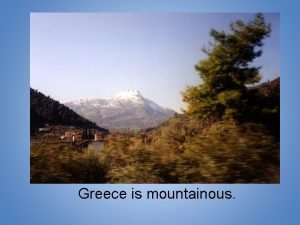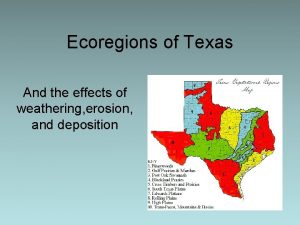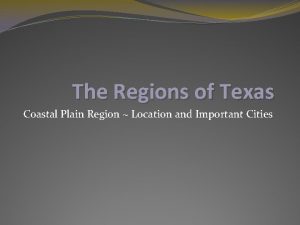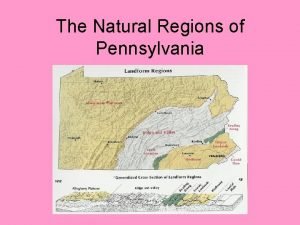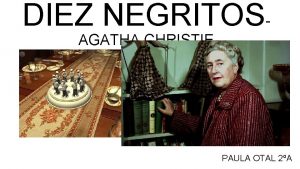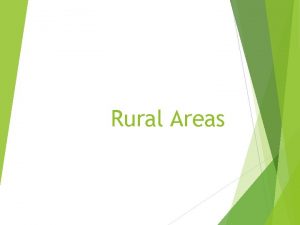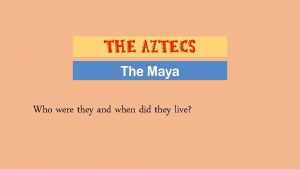Negritos They live in coastal and mountainous areas


























- Slides: 26


Negritos - They live in coastal and mountainous areas. - They are scattered all over the country, in places such as Palawan, Panay, Mindanao, Pampanga, etc.

Negritos Known as “Aetas”. They have dark skin, curly hair and a shorter stature. They are skilled hunters. They are nomadic people because of their supply of food. Many Negritos were dispatched to diff. parts of the country due to the eruption of Mount Pinatubo.

Negritos

Culture of Negritos - They are known to live in houses made of branch grass (when they are not travelling). - They are nomadic people – they travel from place to search for food. - They use spears to catch their fish and bows and arrows to hunt for wild animals.

Culture of Negritos • Negrito houses (when they are not travelling)

Other Pictures of Negritos

Ifugaos - They live in the mountainous regions of Luzon and in massive forests. - They can be seen in the Ifugao province.

Ifugaos They are known for : Making the Banaue Rice Terraces Their engineering skills Their fine carvings and weaving skills. They are industrious, friendly, courteous and talented people.

Banaue Rice Terraces - These terraces were made by hand.

Ifugao Weavings • Weaving is an exclusive task of Ifugao women.

The Bul’ul • This is the one of the most famous carvings of the Ifugaos.

Culture of Ifugaos Rice culture – a man’s social status depends on the amount of rice he harvests; rice is a prestigious crop They don’t bury the dead. They request the dead not to come back. They offer animal sacrifices to the dead as well. *They respect their dead relatives.

A Dead Ifugao

Ibalois - They live in mountainous regions. - Most of them can be found in Southern Benguet.

Benguet - The Ibalois were the 1 st ones to inhabit these lands.

Ibalois Their main source of livelihood is agriculture, and their secondary source is mining. Separated into 2 groups: the abitug(unfortunate) and the laktang(rich) Headed by a Tongtong which is a cornal represented by elders. st settlers of Benguet. 1 Known to be shy people.

Culture of the Ibalois - They practiced mummification. - When they have used up their resources, or when their field become poor and the soil becomes less fertile, they move to other places or higher mountains/areas. - They would usually tell the lowlanders “We are Benguet people”

Mummification - Mummification was only available to the rich people.

Tingguians - They live in mountainous regions of Luzon. - They can be found in Abra, Zambales, Bohol, Basilan and Mindanao.

Tingguians The women are adorn with beads which are wrapped around their shoulders. Women are also known to be tatooed. Their noses are aquilin. They plant their rice in lowlands.

Tingguian Woman

Culture of Tingguians Their dead is buried in a sitting, upright position. (This is also done to some Ifugaos. ) Basi (their local wine) is served in special occasions. During weddings, dowry is given.

Basi

Sources: Images. google. com http: //en. wikipedia. org/wiki/negritos http: //en. wikipedia. org/wiki/ibaloi http: //en. wikipedia. org/wiki/ifugao_people#the_ifuga o http: //en. wikipedia. org/wiki/tinguian http: //igospride. multiply. com/journal/item/60/bengue t_culture http: //library. thinkquest. org/c 003235/tingguian. htp

CREDITS: ™ JARRED CO ™ SPENCER KEH ™ PAEL LAURENA ™ DUSTIN LIM ™ AUSTIN SY
 What 4 seas surround the balkan peninsula
What 4 seas surround the balkan peninsula Www.qulzlet.llve
Www.qulzlet.llve Live healthy be happy
Live healthy be happy Areas of the screen that behave as if they were independent
Areas of the screen that behave as if they were independent Office interface vs industrial interface
Office interface vs industrial interface Elements of wimp
Elements of wimp Rankings: what are they and do they matter?
Rankings: what are they and do they matter? People live in scotland. they are called scots.
People live in scotland. they are called scots. They live analysis
They live analysis They died that we might live
They died that we might live East texas piney woods weathering
East texas piney woods weathering Coastal and continental temperature ranges
Coastal and continental temperature ranges Coastal and plateau tribes
Coastal and plateau tribes Advantages and disadvantages of coastal tourism
Advantages and disadvantages of coastal tourism Coastal sand plains texas
Coastal sand plains texas 1 complete the sentences
1 complete the sentences We seek him here we seek him there
We seek him here we seek him there It is not you they have rejected but me
It is not you they have rejected but me They are they which testify of me
They are they which testify of me Grammar rules frustrate me they're not logical they are so
Grammar rules frustrate me they're not logical they are so For they not know what they do
For they not know what they do Knowledge not shared is wasted
Knowledge not shared is wasted Ocean tides observed at coastal locations
Ocean tides observed at coastal locations Texas coastal plains plants
Texas coastal plains plants Piedmont region pa
Piedmont region pa Appalachian ridge and valley
Appalachian ridge and valley Swanage bay facts
Swanage bay facts
